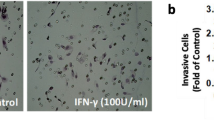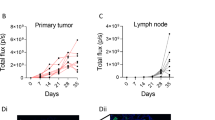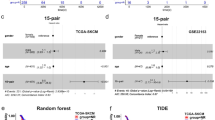Summary
Expression of inducible nitric oxide synthase (iNOS) and its cellular localization was investigated in subcutaneous or lymph node metastases of human melanoma. Immunohistochemistry revealed that iNOS expression was limited to melanoma cells. In samples of patients without distant metastases, the number of iNOS+ tumour cells/total tumour cells was 55% ± 17% (n = 12) compared with 9% ± 8% when distant metastases of lung, liver or brain occurred within an observation period of 3 years (n = 10) (P < 0.001). Western blotting confirmed the expression of iNOS protein in select cases. Notably, iNOS is expressed in regional melanoma metastases and its expression is inversely related to the tumour’s metastatic potential. Thus, iNOS expression may have predictive value for the development of distant metastases of human melanoma.
Similar content being viewed by others
Article PDF
Change history
16 November 2011
This paper was modified 12 months after initial publication to switch to Creative Commons licence terms, as noted at publication
References
Dong, Z., Staroselsky, A. H., Qi, X., Xie, K. & Fidler, I. J. (1994). Inverse correlation between expression of inducible nitric oxide synthase activity and production of metastases in K-1735 murine melanoma cells. Cancer Res 54: 789–793.
Koura, A. N., VanGolen, K., Tsan, R., Radinsky, R., Price, J. E. & Ellis, L. M. (1997). Regulation of genes associated with angiogenesis, growth, and metastasis by specific p53 point mutations in a murine melanoma cell line. Oncol Rep 4: 475–479.
Meßmer, U. K., Ankarcrona, M., Nicotera, P. & Brüne, B. (1994). p53 expression in nitric oxide-induced apoptosis. FEBS Lett 355: 23–26.
Moncada, S., Palmer, R. M. J. & Higgs, E. A. (1991). Nitric oxide: physiology, pathophysiology, and pharmacology. Pharmacol Rev 43: 109–142.
Nathan, C. & Xie, Q. W. (1994). Regulation of biosynthesis of nitric oxide. J Biol Chem 269: 13725–13728.
Schmidt, H.H.H.W. & Walter, U. (1994). NO at work. Cell 78: 919–925.
Pammer, J., Plettenberg, A., Weninger, W., Diller, B., Mildner, M., Uthman, A., Issing, W., Stürzl, M. & Tschachler, E. (1996). CD40 antigen is expressed by endothelial cells and tumor cells in Kaposi’s sarcoma. Am J Pathol 148: 1387–1396.
Thomsen, L. L., Lawton, F. G., Knowles, R. G., Beesley, J. E., Riveros-Moreno, V. & Moncada, S. (1994). Nitric oxide synthase activity in human gynecological cancer. Cancer Res 54: 1352–1354.
Thomsen, L. L., Miles, D. W., Happerfield, L., Bobrow, L. G., Knowles, R. G. & Moncada, S. (1995). Nitric oxide synthase activity in human breast cancer. Br J Cancer 72: 41–44.
Tschugguel, W., Knogler, W., Czerwenka, K., Mildner, M., Weninger, W., Zeillinger, R. & Huber, J. C. (1996). Presence of endothelial calcium-dependent nitric oxide synthase in breast apocrine metaplasia. Br J Cancer 74: 1423–1426.
Xie, K., Huang, S., Dong, Z., Juang, S. H., Gutman, M., Xie, Q. W., Nathan, C. & Fidler, I. J. (1995). Transfection with the inducible nitric oxide synthase gene suppresses tumorigenicity and abrogates metastases by K-1735 murine melanoma cells. J Exp Med 181: 1333–1343.
Xie, K., Dong, Z. & Fidler, I. J. (1996). Activation of nitric oxide synthase gene for inhibition of cancer metastasis. J Leukoc Biol 59: 797–803.
Xie, K., Wang, Y. F., Huang, S. Y., Xu, L., Bielenberg, D., Salas, T., McConkey, D. J., Jiang, W. D. & Fidler, I. J. (1997). Nitric oxide mediated apoptosis of K 1735 melanoma cells is associated with downregulation of Bcl 2. Oncogene 15: 771–779.
Author information
Authors and Affiliations
Rights and permissions
From twelve months after its original publication, this work is licensed under the Creative Commons Attribution-NonCommercial-Share Alike 3.0 Unported License. To view a copy of this license, visit http://creativecommons.org/licenses/by-nc-sa/3.0/
About this article
Cite this article
Tschugguel, W., Pustelnik, T., Lass, H. et al. Inducible nitric oxide synthase (iNOS) expression may predict distant metastasis in human melanoma. Br J Cancer 79, 1609–1612 (1999). https://doi.org/10.1038/sj.bjc.6690256
Received:
Accepted:
Published:
Issue date:
DOI: https://doi.org/10.1038/sj.bjc.6690256
Keywords
This article is cited by
-
Inducible nitric oxide synthase mediates DNA double strand breaks in Human T-Cell Leukemia Virus Type 1-induced leukemia/lymphoma
Retrovirology (2015)
-
Nitric oxide: role in tumour biology and iNOS/NO-based anticancer therapies
Cancer Chemotherapy and Pharmacology (2011)
-
Main roads to melanoma
Journal of Translational Medicine (2009)
-
Inducible nitric oxide synthase expression in melanoma: implications in lymphangiogenesis
Modern Pathology (2009)



